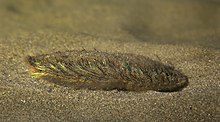Aphrodita
| Aphrodita | |
|---|---|
 |
|
| Aphrodita aculeata | |
| Scientific classification | |
| Kingdom: | Animalia |
| Phylum: | Annelida |
| Class: | Polychaeta |
| Order: | Phyllodocida |
| Suborder: | Aphroditoidea |
| Family: | Aphroditidae |
| Genus: |
Aphrodita Linnaeus, 1758 |
| Type species | |
|
Aphrodita aculeata Linnaeus, 1758 |
|
| Species | |
|
See text |
|
See text
Aphrodita, or sea mouse, is a genus of marine polychaete worms found in the Mediterranea sea and the eastern and western Atlantic Ocean.
The name of the genus is taken from Aphrodite, the Ancient Greek goddess of love. This is because, when viewed ventrally, the animal resembles a human female's genitalia. The English name may either have a similar meaning, or may derive from the supposed resemblance to a bedraggled mouse when washed up on shore.
The body of the sea mouse is covered in a dense mat of (hairlike structures). Adults generally fall within a size range of 7.5 to 15 centimetres (3.0 to 5.9 in), but some grow to 30 centimetres (12 in).
The spines, or setae, on the scaled back of the sea mouse are one of its unique features. Normally, these have a deep red sheen, warning off predators, but when the light shines on them perpendicularly, they flush green and blue, a "remarkable example of photonic engineering by a living organism". This structural coloration is a defense mechanism, giving a warning signal to potential predators. The effect is produced by many hexagonal cylinders within the spines, which "perform much more efficiently than man-made optical fibres".
Aphrodita are typically scavengers. However, Aphrodita aculeata is an active predator, feeding primarily on small crabs, hermit crabs and other polychaete worms including Pectinaria and Lumbriconereis.
Species recognized by the World Register of Marine Species:
...
Wikipedia
